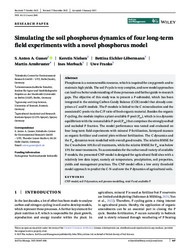Simulating the soil phosphorus dynamics of four long‐term field experiments with a novel phosphorus model
Nielsen, Kerstin
Eichler‐Löbermann, Bettina
Armbruster, Martin
Merbach, Ines
Franko, Uwe
DOI: https://doi.org/10.1111/sum.12881
Persistent URL: http://resolver.sub.uni-goettingen.de/purl?gldocs-11858/11188
Persistent URL: http://resolver.sub.uni-goettingen.de/purl?gldocs-11858/11188
Gasser, S. Anton A.; Nielsen, Kerstin; Eichler‐Löbermann, Bettina; Armbruster, Martin; Merbach, Ines; Franko, Uwe, 2023: Simulating the soil phosphorus dynamics of four long‐term field experiments with a novel phosphorus model. In: Soil Use and Management, Band 39, 2: 867 - 880, DOI: 10.1111/sum.12881.
 |
Dokument öffnen: |
Phosphorus is a nonrenewable resource, which is required for crop growth and to maintain high yields. The soil P cycle is very complex, and new model approaches can lead to a better understanding of those processes and further guide to research gaps. The objective of this study was to present a P‐submodel, which has been integrated in the existing Carbon Candy Balance (CCB) model that already comprises a C and N module. The P‐module is linked to the C mineralization and the associated C‐pools via the C/P ratio of fresh organic material. Besides the organic P cycling, the module implies a plant‐available P‐pool (Pav), which is in a dynamic equilibrium with the nonavailable P‐pool (Pna) that comprises the strongly sorbed and occluded P fraction. The model performance was tested and evaluated on four long‐term field experiments with mineral P fertilization, farmyard manure as organic fertilizer and control plots without fertilization. The C dynamics and the Pav dynamics were modelled with overall good results. The relative RMSE for the C was below 10% for all treatments, while the relative RMSE for Pav was below 15% for most treatments. To accommodate for the rather small variety of available P‐models, the presented CNP‐model is designed for agricultural field sites with a relatively low data input, namely air temperature, precipitation, soil properties, yields and management practices. The CNP‐model offers a low entry threshold model approach to predict the C‐N and now the P dynamics of agricultural soils.
Statistik:
ZugriffsstatistikSammlung:
This is an open access article under the terms of the Creative Commons Attribution License, which permits use, distribution and reproduction in any medium, provided the original work is properly cited.

